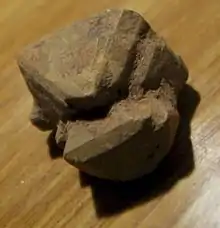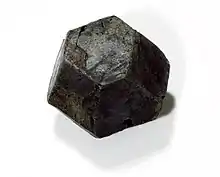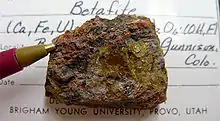Betafite
Betafite is a mineral group in the pyrochlore supergroup, with the chemical formula (Ca,U)2(Ti,Nb,Ta)2O6(OH). Betafite typically occurs as a primary mineral in granite pegmatites, rarely in carbonatites. Defined by the B-site atom Ti, Atencio et al.(2010) combined and considered the ideas portrayed in (Hatert and Burke)(2008) and a modernization of (Hogarth)(1977) system for nomenclature of pyrochlore and betafite in order to further rationalize the naming process of this grouping of minerals. Therefore, Atencio et al. (2010), states that only two of the mineral species that were formerly recognized under the previous nomenclature system of betafite in Hogarth (1977) are now recognized. They are oxyuranobetafite and oxycalciobetafite. Now the term betafite is a synonym or varietal group name under the pyrochlore super group (Christy and Atencio 2013).

| Betafite | |
|---|---|
 Betafite dodecahedron, Locality: Bancroft, Ontario, Canada | |
| General | |
| Category | Oxide minerals |
| Formula (repeating unit) | (Ca,U)2(Ti,Nb,Ta)2O6(OH) |
| Strunz classification | 4.DH.15 |
| Crystal system | Cubic |
| Space group | Fd3m (no. 227) |
| Identification | |
| Color | Brown, Black, Brownish green, Yellow, Greenish black |
| Crystal habit | Massive - Granular |
| Cleavage | None |
| Mohs scale hardness | 5 - 5.5 |
| Luster | Vitreous |
| Streak | Yellowish white |
| Diaphaneity | Translucent to Opaque |
| Density | 3.7 - 4.9 |
| Other characteristics | |
| References | [1] |

Structure
The pyrochlore supergroup minerals conform to the general formula, A2−mB2X6−wY1−n, where the m, w, and n variables represent the parameters that indicate incomplete occupancy of the A, Y, and X sites (Atencio et al. 2010). They crystallize isometric system with a space group of Fd3m or its subgroups where Betafite has a hexoctahedral class (Hogarth 1977). Site A is generally an 8-coordinated cation with a ~1.0 Å radius, B site is generally a 6-coordinated cation, which contains the elements Ti, Nb, and Ta usually for betafite, (Atencio et al. 2010, site X is generally O but can subjugate to OH and F, and site Y is typically an anion but can also be a vacancy, H2O, or a very large monovalent cation, like Cs, K, and Rb.
Origin and uses
The oxycalciobetafite in Camara et al. (2004) occurs in the pyroclastic formation belonging to the main effusive stage of the Vico activity where it is contained within foid-bearing syenite, which also holds optical observances of K-feldspar, and minor amphibole, plagioclase, magnetite, sodalite and rare biotite. While with SEM-EDS, titanite, apatite, and baddeleyite were also observed. While the geologic occurrence of oxycalciobetafite located on the moon has been rather difficult to ascertain. Oxyuranobetafite is also located on the moon and is described in Mokhov et al. (2008).
Betafite is an important ore of thorium, uranium, and niobium. Though, there is no real applicable use as of yet for the accepted betafite species, the pyrochlore super-group that contains the former betafites of Hogarth (1977) are mentioned in Lumpkin and Ewing (1996), Turner (1928) and many others, all with the recurring theme of either extracting uranium, thorium, and niobium from the pyrochlore super-group ores. The depletion of uraninite rich ore bodies has led to the search and mild application of refractory uranium minerals as a source of uranium to keep up with the increasing demands.[1]
References
- Harlow, George, Joseph Peters, and Martin Prinz. "Oxides and Hydroxides." Simon & Schuster's Guide to Rocks and Minerals. New York: Simon & Schuster, 1977. Entry 69. Print.
- Betafite mineral data at Webmineral
- Betafite mineral data at Mindat.org
- Atencio, D., Andrade, M. B., Christy, A. G., Gieré, R., & Kartashov, P. M. (2010). The pyrochlore supergroup of minerals: nomenclature. The Canadian Mineralogist, 48(3), 673-698.doi: 10.3749/canmin.48.3.673
- Camara, F., Williams, C.T., Della Ventura, G., Oberti, R., and Caprilli, E., (2004) Non-metamict betafite from Le Carcarelle (Vico volcanic complex, Italy): occurrence and crystal structure. Mineralogical Magazine, 68, 939-950.
- Christy, A.G., and Atencio, D., (2013) Clarification of status of species in the pyrochlore supergroup. Mineralogical Magazine, 77, 13-20.
- Hatert, F., and Burke, E.A.J., (2008) The IMA-CNMNC Dominant-Constituent Rule Revisited and Extended. The Canadian Mineralogist, 46, 717-728.
- Hogarth, D.D., (1977) Classification and nomenclature of the pyrochlore group. American Mineralogist, 62, 403-410.
- Mokhov, A.V., Kartashov, P.M., Bogatikov, O.A., Ashikhmina, N.A., Magazina, L.O., and Koporulina, E.V., (2008) Fluorite, Hatchettolite, Calcium Sulfate, and Bastnasite-(Ce) in the Lunar Regolith from Mare Crisium. Doklady Earth Sciences, 422, 1178-1180.
- Turner, H.W.,(1928) Review of the Radioactive Minerals of Madagascar. Economic Geology, 23, 62-84.
- Lumpkin, G.R., and Ewing, R.C.,(1996) Geochemical alteration of pyrochlore group minerals: Betafite subgroup. American Mineralogist, 81, 1237-1248.